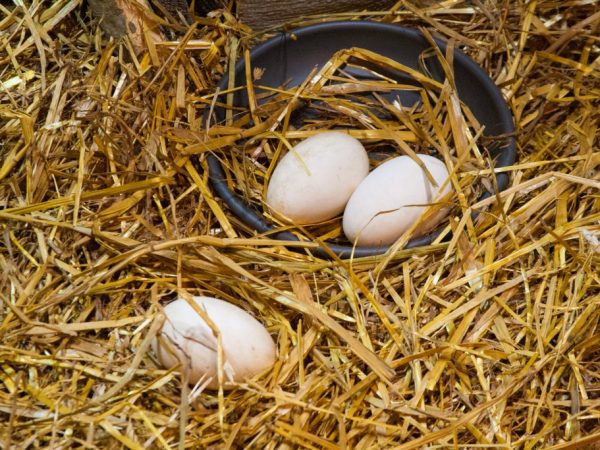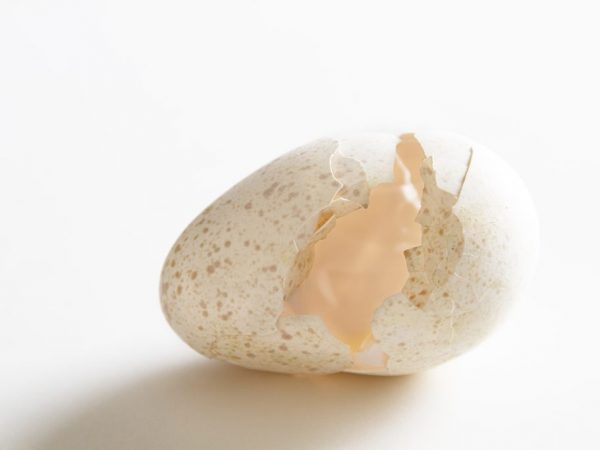Ovoscoping process of turkey eggs by day
In poultry, turkeys are perhaps the most profitable for breeding. They have good muscle mass and fertility. Even though the turkey has a well-developed maternal instinct, in some cases it is necessary to use an incubator. In order to properly raise young growth in an incubator, you need to learn how to ovoscopy turkey eggs every day.

Ovoscoping process of turkey eggs by day
How to choose a biomaterial for a bookmark?
The selection of incubation material is carried out according to a certain scheme, taking into account several factors:
- eggs are taken only from females who are 8 months old;
- keep eggs in dry, clean, well-ventilated areas;
- the incubation material is laid with the blunt edge up;
- it is forbidden to store filling material for more than 10 days, ideally 6 days.
First, an initial examination is carried out, which allows you to visually identify defects. Quality eggs are cone-shaped. Eggs that are too round or oblong should be discarded. All testicles should be the same size. No need to take too large or small.
It is important to remember that before laying, you need to warm up the testicles to 21 degrees. To do this, at night before laying, the biomaterial is laid out in a warmer room. Before placing the testicles in incubator they are disinfected with a manganese solution. All surfaces of the incubator must also be disinfected beforehand.
The dried biomaterial is placed in an incubator in a horizontal position, while it is necessary to mark the opposite sides with a simple pencil, in order to further carry out accurately turning each testicle by 180 degrees. It is not recommended to use markers or felt-tip pens to mark eggs. For the manufacture of a dye, harmful chemical compounds are used that can adversely affect the development of embryos.
What is the electrooscope for?
The initial examination is not enough. The next stage of preparation is the ovoscopy of a turkey egg. For the procedure, you will need a special device ovoscope... Under the lamp, you can identify defects in the development of the embryo at any stage. Initially, they look at the yolk. The size of the airspace is very important. Requirements for the quality of turkey eggs for laying:
- the yolk should turn into white smoothly;
- the air chamber should be located on the blunt side of the testicle and be constantly in one place;
- blood streaks or blotches should not be noted in the protein, its consistency is homogeneous;
- when turning the egg, under the ovoscope, you can see how the yolk moves along the edge very slowly, and then returns to its original position.
In addition to the secondary examination, ovoscopy is performed at different stages of embryo development. The procedure is carried out to discard spoiled eggs, as well as to control climatic conditions.Inspection allows you to adjust, if necessary, temperature or humidity, until this has caused irreversible damage to the embryos. It is important to remember that too frequent use of the ovoscope during the incubation period is also harmful, especially in the last stages, when the shell becomes thin, this can lead to damage to already formed chicks.
How is artificial rearing of chicks carried out?
Turkey it develops in the egg for 28 days. Hatching of chicks can be expected from 25 days. The entire incubation period is divided into three stages. The main thing is to fulfill all the requirements that relate to temperature conditions, humidity and uniform turning of the biomaterial.
From the first to the eighth day, it is recommended to maintain the temperature in the incubator within 37.8 degrees. Air humidity should not exceed 65%. At all stages, it is necessary to regularly rotate the testicles 180 degrees so that the embryo does not stick to the shell. On the eighth day, a second ovoscopy is performed. Discard unfertilized specimens and check if all embryos develop normally.
From the eighth to the fourteenth day, the embryos go through the next stage of development. These days, the laying of the respiratory system takes place. Initially, the embryo breathes through the air chamber. On the fourteenth day, the ovoscope is again used for control.
In the third stage, which lasts up to day 25, changes in metabolism occur. All organ systems are already functioning and the embryos generate heat on their own. In this regard, the ventilation function must be turned on in the incubator in order to avoid overheating. The temperature should not exceed 37.5 degrees.
The chicks enter the hatching phase on the 25-26th day. During this period, it is very important to maintain the humidity level within 70%, otherwise the chicks will not be able to get out of the shell and will die. The air flow at this stage is increased. In no case should you help the turkey poults break the shell, otherwise they will die.
Hatching is an important process

It is necessary to create optimal conditions for the emergence of chicks
Most of the chicks are born on the 27th day. Do not open the lid of the apparatus when the hatching process has started. Cold air from the outside can lead to hypothermia only that hatched chicks. Birds are taken from the incubator only after all hatch and dry out.
When chicks hatch, the incubator must be ventilated to ensure adequate air flow. At the same time, a draft must not be allowed. All chicks cannot hatch at the same time. There may be a 24 hour difference between the birth of the first and the last. The bulk hatches in 10 hours, during this period the temperature drops to 37 degrees, and after drying and removing the hatched individuals, the temperature is again raised to 37.5.
What mistakes do poultry farmers make in artificial breeding?
Often, when laying turkey eggs in an incubator, novice poultry farmers make many mistakes. The ovoscope is just needed to monitor the state of the eggs during the entire incubation period. The timely noticed pathology in development allows you to quickly adjust the work of the incubator and avoid losses.
One of the first mistakes is non-compliance with the temperature regime. Even a slight increase in temperature leads to instant overheating. Such a mistake leads to the development of all kinds of pathologies. Many chicks do not pull in the yolk. Overheating is the reason for early hatching, and with a lack of heat, turkeys begin to hatch much later.
The second mistake is the poor selection of biomaterial for the bookmark. When eggs of different sizes are laid in the incubator, it is impossible to ensure uniform heating of the entire biomaterial. Too small testicles will overheat, while large ones on the contrary. Eggs with micro cracks or damaged air chamber should not be set.
The moisture percentage plays a decisive role in the development of the chicks. Waterlogged air becomes the reason for pecking at a later date, and most of the chicks do not even live up to this moment, but choke in the amniotic fluid. Dry air causes the shell to harden. Turkey poults are trying to get out of their house ahead of time, but they cannot do this, because the shell is too strong.
Another important point that is the key to the normal development of embryos is regular turning. If this procedure is neglected, the embryos dry up to the shell and die. If the breeder stopped turning the testicles at a later date, then there is a high probability of the appearance of babies with congenital defects.
Final part
Ovoscopy of turkey eggs is a rather serious procedure. The laying of turkey eggs in the incubator follows the scheme. The first step is a visual primary examination of the entire biomaterial. You should not take biomaterial heavily smeared with droppings, because you cannot wash the testicles, and during incubation, harmful substances can penetrate through the pores of the shell and provoke the development of pathologies. You can watch a training video on the initial examination of eggs and learn a lot of new information for yourself.
A secondary examination is carried out using an ovoscope. This is done on the day before laying the eggs, when all the material has already been treated with a disinfectant and dried. You will need an ovoscope throughout the entire incubation period to control the climatic conditions in the device. Identifying errors in the early stages of incubation allows you to quickly correct them and significantly reduce the risk of giving birth to underdeveloped chicks with pathologies.
The next ovoscopy is performed on the eighth day, when the first stage of development has been completed. Then the eggs are ovoscoped on the fourteenth day from the beginning of the laying. Already from the 25th day, the appearance of the first chicks can be observed. Do not open the lid of the apparatus when hatching, otherwise the chicks will catch cold and may die. If you are very interested in knowing how babies hatch, you can watch the video.


